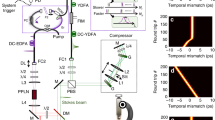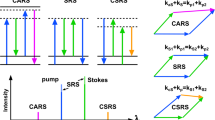Abstract
Stimulated Raman scattering microscopy allows label-free chemical imaging and has enabled exciting applications in biology, material science and medicine. It provides a major advantage in imaging speed over spontaneous Raman scattering and has improved image contrast and spectral fidelity compared to coherent anti-Stokes Raman scattering. Wider adoption of the technique has, however, been hindered by the need for a costly and environmentally sensitive tunable ultrafast dual-wavelength source. We present the development of an optimized all-fibre laser system based on the optical synchronization of two picosecond power amplifiers. To circumvent the high-frequency laser noise intrinsic to amplified fibre lasers, we have further developed a high-speed noise cancellation system based on voltage-subtraction autobalanced detection. We demonstrate uncompromised imaging performance of our fibre-laser-based stimulated Raman scattering microscope with shot-noise-limited sensitivity and an imaging speed up to 1 frame s−1.
This is a preview of subscription content, access via your institution
Access options
Subscribe to this journal
Receive 12 print issues and online access
$209.00 per year
only $17.42 per issue
Buy this article
- Purchase on Springer Link
- Instant access to full article PDF
Prices may be subject to local taxes which are calculated during checkout




Similar content being viewed by others
References
Zumbusch, A., Holtom, G. R. & Xie, X. S. Three-dimensional vibrational imaging by coherent anti-Stokes Raman scattering. Phys. Rev. Lett. 82, 4142–4145 (1999).
Evans, C. L. & Xie, X. S. Coherent anti-Stokes Raman scattering microscopy: chemical imaging for biology and medicine. Annu. Rev. Anal. Chem. 1, 883–909 (2008).
Ploetz, E., Laimgruber, S., Berner, S., Zinth, W. & Gilch, P. Femtosecond stimulated Raman microscopy. Appl. Phys. B 87, 389–393 (2007).
Freudiger, C. W. et al. Label-free biomedical imaging with high sensitivity by stimulated Raman scattering microscopy. Science 322, 1857–1861 (2008).
Ozeki, Y., Dake, F., Kajiyama, S., Fukui, K. & Itoh, K. Analysis and experimental assessment of the sensitivity of stimulated Raman scattering microscopy. Opt. Express 17, 3651–3658 (2009).
Nandakumar, P., Kovalev, A. & Volkmer, A. Vibrational imaging based on stimulated Raman scattering microscopy. New J. Phys. 11, 033026 (2009).
Bloembergen, N. The stimulated Raman effect. Am. J. Phys. 35, 989–1023 (1967).
Evans, C. L. et al. Chemical imaging of tissue in vivo with video-rate coherent anti-Stokes Raman scattering microscopy. Proc. Natl Acad. Sci. USA 102, 16807–16812 (2005).
Saar, B. G. et al. Video-rate molecular imaging in vivo with stimulated Raman scattering. Science 330, 1368–1370 (2010).
Ganikhanov, F., Evans, C. L., Saar, B. G. & Xie, X. S. High-sensitivity vibrational imaging with frequency modulation coherent anti-Stokes Raman scattering (FM CARS) microscopy. Opt. Lett. 31, 1872–1874 (2006).
Min, W., Freudiger, C. W., Lu, S. & Xie, X. S. Coherent nonlinear optical imaging: beyond fluorescence microscopy. Annu. Rev. Phys. Chem. 62, 507–530 (2011).
Owyoung, A. Sensitivity limitations for CW stimulated Raman spectroscopy. Opt. Commun. 22, 323–328 (1977).
Ozeki, Y. et al. Stimulated Raman scattering microscope with shot noise limited sensitivity using subharmonically synchronized laser pulses. Opt. Express 18, 13708–13719 (2010).
Ji, M. et al. Rapid, label-free detection of brain tumors with stimulated Raman scattering microscopy. Sci. Transl. Med. 5, 201ra119 (2013).
Lin, C.-Y. et al. Picosecond spectral coherent anti-Stokes Raman scattering imaging with principal component analysis of meibomian glands. J. Biomed. Opt. 16, 021104 (2011).
Ozeki, Y. et al. High-speed molecular spectral imaging of tissue with stimulated Raman scattering. Nature Photon. 6, 845–851 (2012).
Kong, L. et al. Multicolor stimulated Raman scattering microscopy with a rapidly tunable optical parametric oscillator. Opt. Lett. 38, 145–147 (2013).
Ganikhanov, F. et al. Broadly tunable dual-wavelength light source for coherent anti-Stokes Raman scattering microscopy. Opt. Lett. 31, 1292–1294 (2006).
Jones, D. J. et al. Synchronization of two passively mode-locked, picosecond lasers within 20 fs for coherent anti-Stokes Raman scattering microscopy. Rev. Sci. Instrum. 73, 2843–2848 (2002).
Pegoraro, A. F. et al. Optimally chirped multimodal CARS microscopy based on a single Ti:sapphire oscillator. Opt. Express 17, 2984–2996 (2009).
Krauss, G. et al. Compact coherent anti-Stokes Raman scattering microscope based on a picosecond two-color Er:fiber laser system. Opt. Lett. 34, 2847–2849 (2009).
Gambetta, A. et al. Fiber-format stimulated-Raman-scattering microscopy from a single laser oscillator. Opt. Lett. 35, 226–228 (2010).
Baumgartl, M. et al. All-fiber laser source for CARS microscopy based on fiber optical parametric frequency conversion. Opt. Express 20, 4484–4493 (2012).
Lefrancois, S. et al. Fiber four-wave mixing source for coherent anti-Stokes Raman scattering microscopy. Opt. Lett. 37, 1652–1654 (2012).
Bégin, S. et al. Coherent anti-Stokes Raman scattering hyperspectral tissue imaging with a wavelength-swept system. Biomed. Opt. Express 2, 1296–1306 (2011).
Nose, K. et al. Sensitivity enhancement of fiber-laser-based stimulated Raman scattering microscopy by collinear balanced detection technique. Opt. Express 20, 13958–13965 (2012).
Hobbs, P. C. D. Shot noise limited optical measurements at baseband with noisy lasers. Proc. SPIE 1376, 216–221 (1991).
Hobbs, P. C. D. Building Electro-optical Systems: Making It All Work (Wiley, 2000).
Kieu, K. & Mansuripur, M. Femtosecond laser pulse generation with a fiber taper embedded in carbon nanotube/polymer composite. Opt. Lett. 32, 2242–2244 (2007).
Kieu, K., Jones, J. & Peyghambarian, N. High power femtosecond source near 1 micron based on an all-fiber Er-doped mode-locked laser. Opt. Express 18, 21350–21355 (2010).
Andrianov, A., Anashkina, E., Muravyev, S. & Kim, A. All-fiber design of hybrid Er-doped laser/Yb-doped amplifier system for high-power ultrashort pulse generation. Opt. Lett. 35, 3805–3807 (2010).
Hopt, A. & Neher, E. Highly nonlinear photodamage in two-photon fluorescence microscopy. Biophys. J. 80, 2029–2036 (2001).
Fu, Y., Wang, H., Shi, R. & Cheng, J.-X. Characterization of photodamage in coherent anti-Stokes Raman scattering microscopy. Opt. Express 14, 3942–3951 (2006).
Nan, X., Potma, E. O. & Xie, X. S. Nonperturbative chemical imaging of organelle transport in living cells with coherent anti-Stokes Raman scattering microscopy. Biophys. J. 91, 728–735 (2006).
Obarski, G. E. & Hale, P. D. How to measure relative intensity noise in lasers. Laser Focus World 35, 273–278 (1999).
Acknowledgements
The authors thank P. Hobbs, J. McArthur and J. Trautman for discussions. The authors thank D. Fu and F.-K. Lu for help with sample preparation. This material is based on work supported by the National Science Foundation (NSF; grant no. 1214848 to C.W.F.) and by the National Institutes of Health (NIH; grant no. 5R01EB010244 to X.S.X). This work was performed in part at the Center for Nanoscale Systems (CNS), a member of the National Nanotechnology Infrastructure Network (NNIN), which is supported by the NSF (under grant no. ECS-0335765). CNS is part of Harvard University. KK and NP would like to acknowledge the support from the CIAN NSF ERC under grant #EEC-0812072 and the State of Arizona’s TRIF funding.
Author information
Authors and Affiliations
Contributions
C.W.F. and K.Q.K. designed and characterized the fibre-laser system. W.Y. and G.R.H. designed and characterized the autobalanced detector. C.W.F. and W.Y. performed the imaging experiments. C.W.F., X.S.X., N.P. and K.Q.K. conceived the project and supervised its implementation. C.W.F., W.Y., K.Q.K., N.P. and X.S.X. wrote the manuscript and all authors commented on it.
Corresponding authors
Ethics declarations
Competing interests
Harvard University and University of Arizona has filed a patent application based on the current work. C.W.F. and X.S.X. have financial interests in Invenio Imaging Inc. K.Q.K. has financial interests in KPhotonics LLC. Any opinions, findings, conclusions or recommendations expressed in this material are those of the authors and do not necessarily reflect the views of the NSF or NIH.
Supplementary information
Supplementary information
Supplementary information (PDF 820 kb)
Supplementary information
Supplementary movie (AVI 3134 kb)
Supplementary information
Supplementary movie (AVI 4720 kb)
Supplementary information
Supplementary movie (MOV 901 kb)
Supplementary information
Supplementary movie (MOV 6383 kb)
Rights and permissions
About this article
Cite this article
Freudiger, C., Yang, W., Holtom, G. et al. Stimulated Raman scattering microscopy with a robust fibre laser source. Nature Photon 8, 153–159 (2014). https://doi.org/10.1038/nphoton.2013.360
Received:
Accepted:
Published:
Issue Date:
DOI: https://doi.org/10.1038/nphoton.2013.360
This article is cited by
-
Artificial-intelligence-based molecular classification of diffuse gliomas using rapid, label-free optical imaging
Nature Medicine (2023)
-
Stimulated Raman histology facilitates accurate diagnosis in neurosurgical patients: a one-to-one noninferiority study
Journal of Neuro-Oncology (2022)
-
Neuropathological interpretation of stimulated Raman histology images of brain and spine tumors: part B
Neurosurgical Review (2022)
-
1/f-noise-free optical sensing with an integrated heterodyne interferometer
Nature Communications (2021)
-
Quantum-enhanced nonlinear microscopy
Nature (2021)



